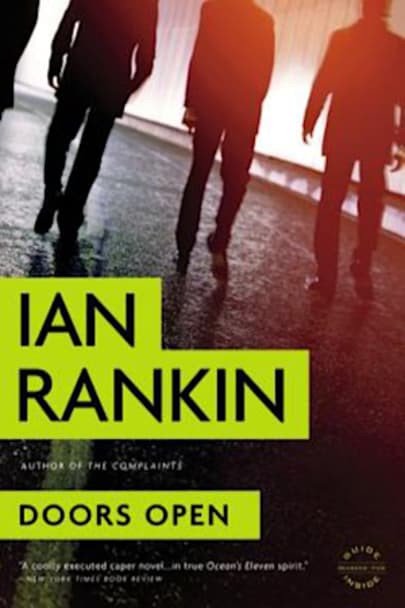Three friends descend upon an art auction in search of some excitement. Mike Mackenzie-retired software mogul, bachelor and fine art enthusiast-wants something that money can’t buy. Fellow art-lover Allan Cruickshank is bored with his banking career and burdened by a painful divorce. And Robert Gissing, an art professor, is frustrated that so many paintings stay hidden in corporate boardrooms, … safes and private apartments. After the auction-and a chance encounter with crime boss Chib Calloway-Robert and Allan suggest the “liberation” of several paintings from the National Gallery, hoping Mike will dissuade them. Instead, he hopes they are serious.
As enterprising girlfriends, clever detectives, seductive auctioneers and a Hell’s Angel named Hate enter the picture, Ian Rankin creates a highly-charged thriller, a faced-past story of second guesses and double crosses that keep changing the picture, right until the harrowing finish.
more



Doors Open is an Ian Rankin novel, but not a Rebus novel. This means the setting is familiar for Rankin – the gray stone and grayer skies of Edinburgh, angst about the city’s class divisions and redevelopment, Scottish angst about the English and tourists (much the same thing here) – but without that gloomy DI mourning the loss of most everything while hoisting endless pints.
The setup: a bored millionaire, a covetous banker, and an art professor walk into a bar (no, it’s not the start of a joke) and plan to steal their favorite paintings from the National Gallery’s storage dungeon in the suburbs. As the plan grows, it attracts a local mafia kingpin, a most unreliable student artist and his Lady Macbeth-like girlfriend, various police detectives, and an enormous Danish Hell’s Angel called Hate. Moral boundaries are crossed, trusts are betrayed, and bad things happen to bad people and good alike.
The main characters are all clearly drawn, individual personalities who are easy to visualize and cast in your mental movie. The dialog is crisp and fits the mouths out of which it comes. (Fear not the Scottishness; the dialog includes enough “wee” and “nae” and “aye” to remind you you’re north of Hadrian’s Wall, but doesn’t spin out into Taggart [or even Monarch of the Glen] territory.) Locations tend to be pencil sketches rather than oils, enough of an outline to give you the gist of things but not enough to establish much atmosphere. Because Edinburgh crime is a milieu Rankin has spent his life exploring, his command of the hard men and the feuding cops is sure and steady.
That’s the good. The demerits are more diffuse and take on the aspects of an aftertaste. The book starts out as a caper story – think of a severely downsized Edinburgher Ocean’s Eleven – and creeps slowly into something darker. The two moods don’t necessarily mesh well. That this trio of upstanding citizens actually goes through with a heist of this sort – no matter the amount of justification Rankin lays out – is a stretch you simply have to swallow hard and accept. The plot probably would’ve worked better had Rankin’s hard men been the authors and finishers of the scheme, leaving him to spend more time on the organized-crime angle that actually is a prime driver behind real-world art theft. (As it is, our acquisitive millionaire is just too close to Thomas Crown for readers to not notice the family resemblance.) Unlike what I remember of the Rebus books I read some time ago, Edinburgh is less a physical presence than a series of place names. Finally, there’s a throwaway not-quite-romance between the millionaire and a pretty auctioneer that seems to exist mostly to justify the rich man’s choice of stolen paintings, and ends on a where-did-that-come-from note.
I understand there’s a made-for-TV movie version of Doors Open, which is entirely expected, since in many ways it has the texture of its own novelization. It reminds me more of a toned-down Guy Ritchie film than an Ian Rankin novel. It’s not bad, and it’s certainly a fast read. It’s just not especially evocative or memorable. Doors Open is one of those books that allow you to pass that coast-to-coast flight enjoyably, yet you don’t feel too bad if you forget it on the plane.
Relatable characters pursuing a terrible idea, and it’s going to end in disaster, but the journey there will be quite a bit of fun. The setting in Edinburgh contributes a great deal to the story. The author lets the reader remain a step ahead of the characters, which is especially effective with this novel. Very highly recommended!